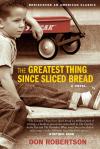Robertson, Don. The Greatest Thing Since Sliced Bread. New York: Harper Paperbacks, 2008. (Originally published in hardback in 1965.)
Paperbacks, 2008. (Originally published in hardback in 1965.)
Nine-year-old Morris Bird III is a timid sort of boy with a precocious sense of right and wrong. After hearing his teacher describe the brave deeds of James A. Garfield, Morris makes up his mind to atone for all the lily-livered mistakes he’s made and earn himself some “selfresepect.” The best course of action, he decides, is to embark on an epic pedestrian journey to see his best friend, who just moved a whopping two miles away to the St. Clair-Superior neighborhood of Cleveland. As fate would have it, the day he chooses is October 20, 1944 — the day of the infamous East Ohio Gas Explosion. (Also see the Cleveland Memory Project photos of the explosion and aftermath.)
(Because I like looking at city maps, I’ve recreated approximately the walking route that Morris Bird III used. Point B is the epicenter of the Gas Explosion disaster.)
What interested me most about The Greatest Thing Since Sliced Bread was the portrait of two Cleveland neighborhoods — Hough and St. Clair-Superior — that took a huge beating in the postwar suburban flight epidemic (and which have never entirely recovered). This was a pre-Rust Belt era. Cleveland was a more densely populated place where people lived smaller, more localized lives, where they walked to the store and rode streetcars to work, a place where East 63 and St. Clair and East 91 and Hough were thought of as worlds apart, and not just to a child’s mind.
It’s tempting to dismiss The Greatest Thing Since Sliced Bread as a mere nostalgia piece. There are, in American literature, a lot of literary reminiscences about being a child during the 1940s. But such a distinction misses the point: the book is a tragic coming-of-age tale set against the backdrop of one of the worst industrial accidents in American history, made doubly tragic by the fact that nine is awfully young to come of age. (After all, a grown man would not normally feel nostalgic about seeing his best pal incinerated right before his eyes.)
It’s also important to note that the book was first published shortly before a conflagration of a different kind — the Hough Riots, which took place in the neighborhood where Morris Bird III lived. As Mark Winegardner illustrates in Crooked River Burning, the Hough Riots were as good a symbol as any of Cleveland’s own loss of innocence.
Don Robertson earned the Cleveland Arts Prize in 1966 for The Greatest Thing Since Sliced Bread. He wrote two additional books featuring Morris Bird III, The Sum and Total of Now and The Greatest Thing that Almost Happened. The Society for the Study of Midwestern Literature presented Robertson with the Mark Twain Award in 1991.